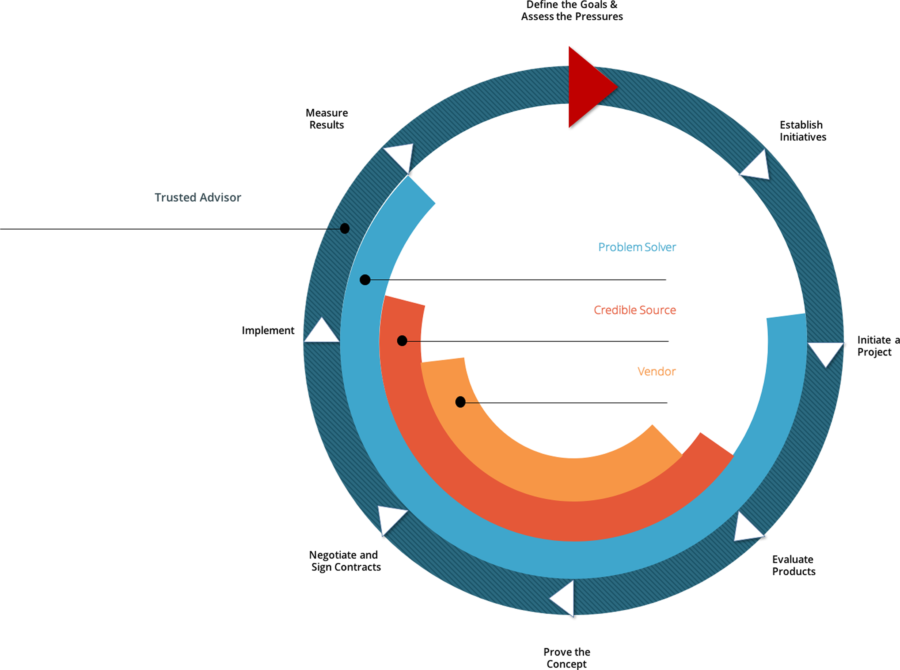Business needs drive the customer’s decision process. Ideally you are helping them shape their needs and crafting an initiative with them to meet their requirements. Whether you are involved or not, the decision cycle will follow a similar pattern, and understanding that cycle will inform your activities.
The stages of the Customer’s Decision Cycle are:
- Define the goals and assess the pressures
- Establish initiatives
- Initiate project
- Evaluate products
- Prove concept
- Negotiate and sign contracts
- Implement
- Measure results
- (Start all over again).
Depending on the relationship you have with the customer, you will engage with the customer at different stages of the Customer’s Decision Cycle.
THE CUSTOMER’S DECISION CYCLE

From the definitions of the Levels of Relationship, mapped to the Customer’s Decision Cycle, you can see that as a Product Vendor you only enter the process when the customer is ready to evaluate products – and then you are out of there. You are generally not involved in measuring the results of your work. In this scenario, either relationships are not needed for the product you sell, or you have not managed to establish even a modicum of relationship success. Price will be the single arbiter of success. Some people refer to the salesperson in this situation (perhaps pejoratively) as a ‘drive-by seller.’
Moving up the relationship pyramid, notice that your role in the customer decision making process expands. At the Credible Source level, you are now entering the process just before the customer is ready to evaluate products or solutions to address their needs. But you exit before the results of the project come to light, so you’re still not viewed as a business partner.
As a Problem Solver, your involvement expands further. Now you enter the process just before the customer has initiated a project and you are involved in the measurement of the results. You have the opportunity to communicate the value that you delivered and you are in a position to work with the customer post-sale as well as pre-sale.
At the Trusted Advisor level, you really don’t ever enter – or exit – the process. Your involvement with the customer is more cyclical. You may recommend areas that the customer should investigate and develop. Or, when the customer has a need, they come to you and together you assess the problem.
A Trusted Advisor has extensive knowledge of the customer’s business. Often, you will identify opportunities for the customer to improve their business even before the customer has identified those needs themselves. Understanding the customer’s business, uncovering needs and requirements, and defining solutions for the customer differentiates you in the account and permits you to gain a large measure of influence over the decision process.
What do you suppose happens to the number of competitors when you enter the decision process earlier? Clearly, if you are doing your job well, and are helping the customer uncover their needs, you have a distinct competitive advantage, and the customer will see less reason to go to the market to look for alternative suppliers. That way the number of competitors is reduced and the pressure on price is correspondingly decreased. A clear measure of your Trusted Advisor status is the number of non-competitive opportunities in which you are involved.
Operating at Trusted Advisor level with your customer is certainly a desirable goal. But, if your customer is not willing to invest with you at this level then you are wasting your resources and potentially endangering your relationship with the customer. Conversely, if your customer does want to work with you at the Trusted Advisor level and you are operating at the Product Vendor level, you are opening yourself up for competitive vulnerability and risk.
Part of your mission is to deliver value. To do this you must clearly understand what your customer values and how, based on your available resources, you can deliver upon that value.
As I reported in my 2013 book, Account Planning in Salesforce, Marc Benioff, founder and CEO of Salesforce, has been a great example to his company of building relationships with customers, founded on mutual authentic engagement in pursuit of shared goals. One such example is the relationship developed between Salesforce and Burberry. In June 2012, Angela Ahrendts, then CEO of Burberry, appeared on the cover of Fortune magazine. As Fortune told the story:
Last May, Burberry CEO Angela Ahrendts flew to California from her London headquarters to introduce herself to an executive she thought could be critical to the future of her business: Salesforce.com CEO Marc Benioff. When the two met at the Ritz-Carlton in Half Moon Bay, they stood in the hall batting around ideas for 15 minutes before even sitting down. Ahrendts explained her vision: to create a company where anyone who wanted to touch the brand could have access to it. She just needed a digital platform to make it happen.

Benioff sketched a diagram of how Burberry could become a ‘social enterprise,’ overlaying technology like Salesforce, SAP, Twitter, and Facebook atop the entire company. (Benioff signed the drawing “Angela + Marc = LIKE,” and Ahrendts reportedly keeps the framed original in her office.)
“I told him, ‘I think I finally met someone who talks faster and has more energy than I do,’” she says. “We just connected.”
The Burberry / Salesforce story is a great example of how a supplier took the time to create value for his customer by taking the customer’s perspective. In this case, Salesforce is viewed as a co-traveler on Burberry’s journey, the apogee of the supplier / customer relationship.
As you take the time to adopt your customer’s perspective, you will have arrived at a place where you can take out your own napkin with your customer, and sketch your joint vision as you build your relationship with your customers and develop your mutual success plan.
You don’t have to be a CEO to make this work. While this story is about the relationship between two high-flying CEOs, similar stories, albeit with less media-worthy protagonists, are happening every day between great salespeople and their customers.
But staying with this story: When Marc Benioff sat down with Angela Ahrendts to paint his vision of the Burberry Social Enterprise, you can be sure that he first learned about her vision for Burberry. He focused on making Burberry successful, and making Ahrendts a hero through multiple public appearances at Salesforce events. In 2014, she went on to become SVP of Apple‘s retail and online stores, overseeing online retail and Apple‘s 478 high-earning bricks-and-mortar stores. Collecting an annual compensation package of $25 million, Ahrendts is the first woman on Apple CEO Tim Cook‘s executive team. Announcing her appointment in 2014, Forbes credited her with righting ‘the sinking fashion house.’ It’s probably a stretch to say that Marc Benioff was responsible for Angela Ahrendts’ career progression, but he certainly cared about her success.
That’s one of the core elements of a trusted business relationship.
This is an extract from my book: Digital Sales Transformation in a Customer First World.
If you want to read more of my blogs please subscribe to Think for a Living blog. Follow me on Twitter or connect on LinkedIn. I want you to agree or disagree with me, but most of all: I want you to bring passion to the conversation.
Donal Daly is Executive Chairman of Altify having founded the company in 2005. He is author of numerous books and ebooks including the latest Amazon #1 Bestseller Digital Sales Transformation in a Customer First World (Nov 3, 2017) and his previous Amazon #1 Best-sellers Account Planning in Salesforce and Tomorrow | Today: How AI Impacts How We Work, Live, and Think. Altify is Donal’s fifth global business enterprise.

